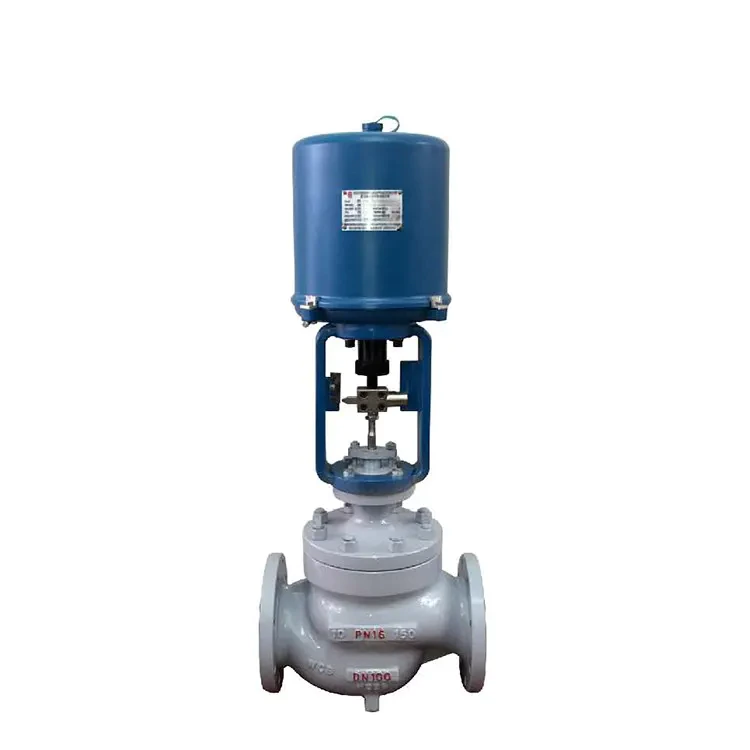COVNA Products


COVNA Electric Sleeve Control Valve
The electric single-seat (sleeve) adjustment valve boasts a compact design and exceptional performance, positioning it as a premium base electric control valve. It is engineered for production process control systems that handle general fluid media. This valve is renowned for its dependable operation, minimal seat leakage, robust flow characteristics, broad adjustment range, and streamlined structure that ensures an unobstructed flow path. With excellent performance and stable operation, this product series effectively meets diverse control requirements in a wide range of applications.
- Model: Electric control valve
- Size Range: 1'' to 12''
- Pressure Range: 1.6 to 6.4MPa
- Material: Stainless Steel, WCB
Technical Parameters of Valve Actuator
| Type | Electric actuator, intelligent integrated |
| Usage | regulating |
| Power supply | 220VAC ±10 % 50Hz, 380VAC ±10 % 50Hz |
| Control signal | 4-20mA.DC, 1~5V DC |
| Action to close | Input signal increase, valve stem descend, valve close |
| Action to open | Input signal increase, valve stem ascend, valve open |
| Lag | ≤0.8 %FS |
| Linear type | ≤1 %FS |
| Operating temperature | WCB: -40℃~+250℃, -40℃~+450℃
Stainless Steel: -40℃~+250℃, -60℃~+450℃ |
| Intrinsic flow characteristics | Straight line, equal percentage(inherent adjustable ratio 50:1) |
Technical Parameters of Valve Body
| Sleeve electric control valve indicators technical parameter | |
| Basic error | ±1.0 % |
| Backlash | 1% |
| Deadzone | 1% |
| Leakage | 5*103 valve rated capacity |
| Rated flow characteristics | ±10% |
| Intrinsic flow characteristics | slope±30% |
| Single-seat electric indicators control valve technical parameter | |
| Basic error | ±2.5 % |
| Backlash | 1.5% |
| Deadzone | 3% |
| Leakage | 1*10^(-4) valve rated capacity |
| Rated flow characteristics | ±10% |
| Intrinsic flow characteristics | slope±30% |
COVNA Cast Steel Electric Actuator Globe Control Valve Overview:
This product features the 3810L series electric actuator paired with a compact single-seat (sleeve) regulating valve. The actuator's integrated electronic controller eliminates the need for an additional servo amplifier, offering high precision and simple installation. Its balanced valve core minimizes unbalanced forces even at high pressure differences for stable performance, while the enlarged spool guide surface reduces oscillations from eddy currents and shocks, thereby protecting against damage. Additionally, it cuts noise by nearly 10dB compared to typical single or double seat valves, and its straightforward design allows for easy assembly and disassembly.
The actuator on my automated valve operates, but the valve won’t turn. Why?
Most likely the valve stem or actuator coupling is broken.
Why doesn’t my valve open or close completely when the actuator operates it?
The electric actuator limit switches or the pneumatic actuator position stops are not correctly adjusted.
When I energize the solenoid on my pneumatic actuated valve, the valve won’t turn. How come?
Probably because there is no air pressure to the solenoid or dirt has jammed it. Also, debris might be trapped inside the valve. Or, the air pressure is not sufficient to operate the actuator. Remember: measure air pressure at the actuator, not at the compressor.
Can I buy an actuator from one manufacturer and mount it to a valve from another manufacturer?
Maybe. First, be sure that the actuator torque output is sufficient to turn the valve reliably. Second, you will have to fabricate a custom mounting bracket and coupling to connect the actuator to the valve.
What happens if I lose power to my electric actuator in the middle of an actuation cycle?
The valve will stop somewhere between full open and close. When power is reapplied to the original circuit, the actuator will complete the cycle.
I ordered a fail open pneumatic actuated valve by mistake. I needed a fail closed one. What can I do?
To make the change just remove the actuator from the valve and turn it, or the valve stem, 90 degrees and remount the actuator.
I’ve installed my automated valve in the line, but now I don’t know if the valve is in the open or closed position. How can I find out?
Remove the actuator from the valve and check the valve stem. Most ball valves have stem flats at right angles to the flow when the valve is in the off position. On butterfly valves check the stem flow arrow marking.
Do I have to have the solenoid valve that controls the air supply to my pneumatic actuator mounted right on the actuator?
Remove the actuator from the valve and check the valve stem. Most ball valves have stem flats at right angles to the flow when the valve is in the off position. On butterfly valves check the stem flow arrow marking.
How do I wire up my electric actuator?
Check the electric wiring schematic that came with the actuator for the correct hookup. Sometimes a copy is inside the actuator cover. If it is missing, don’t guess about the connections. Call the manufacturer for a schematic.
I’ve just installed an electric actuated valve and when I power it, it turns the valve 360 degrees and won’t shut off. What’s wrong?
The actuator is wired incorrectly (check the schematic accompanying the actuator), or the external control switch is not the correct type for the actuator.
My electric actuators cycle time is way too fast, can I slow it down?
Not unless you bought it with an optional speed control.
I just replaced a solenoid valve with an electric actuated valve and it won’t work. Why?
Actuators and solenoid valves require different types of electrical control switches. SPDT for actuators, SPST for solenoids. Check the actuator wiring schematic for the correct wiring and switch type.












